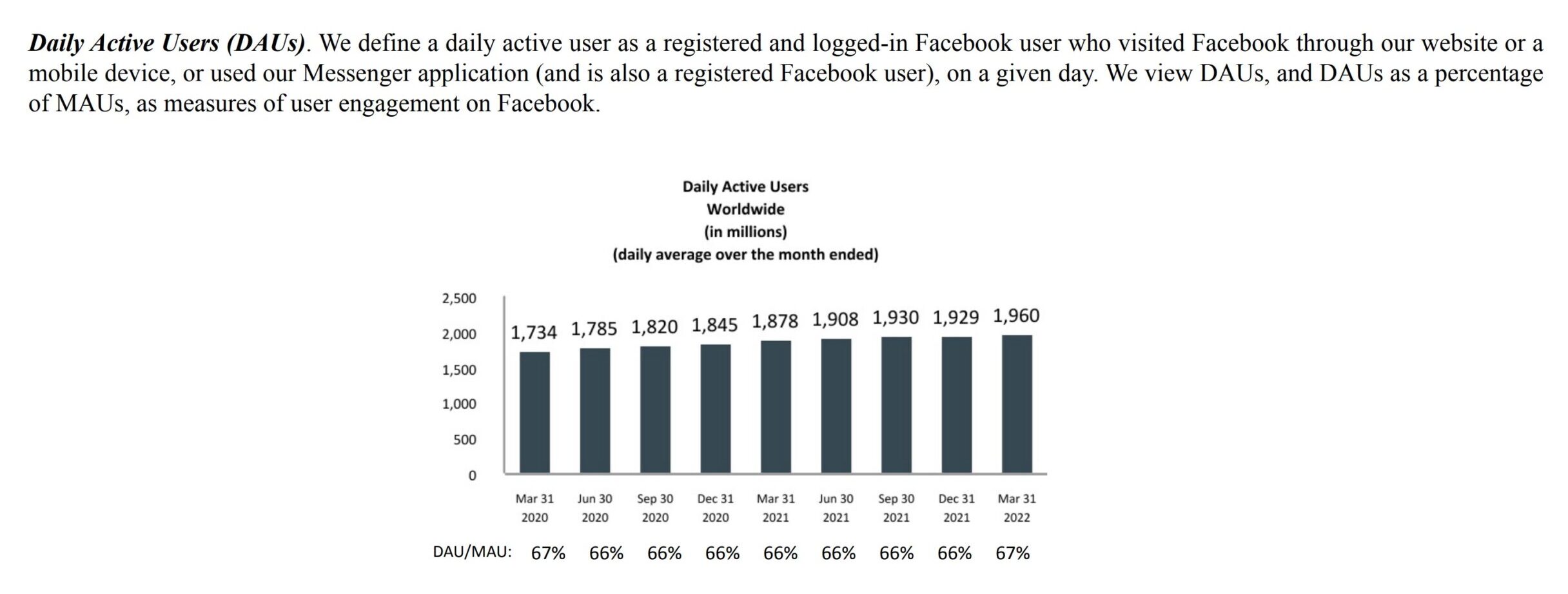What are Daily Active Users (DAU)?
The Daily Active Users (DAU) metric measures user engagement by counting the unique users or visitors that interacted with an app or site on a particular date.

How to Calculate Daily Active Users (DAU)?
DAU captures the total number of unique users on a website or mobile application on a specific date.
DAU, short for “daily active users”, counts the number of unique users that were active on an app or site on a given day, i.e. captures the total number of unique users that opened a site or app in the past 24 hours.
Unique users are defined as a visitor to a website or users of an app (i.e. downloaded and accessed the app), where the user actively participated/used the website or app.
The term “unique” means that users that engaged with an app over ten times in one day are only counted as a single active user.
Metrics such as DAU measure the engagement level of customers with a specific product, such as a website, mobile application, or online platform.
The DAU metric is categorized as a consumer metric used to track user engagement, which is why media companies (and the market) pay such close attention to the metric.
In short, higher user engagement indicates greater revenue upside potential, with the opposite true for low user engagement.
Why is DAU Important? (Unpaid vs. Paid Users)
Higher user engagement implies that users derive more value from the product, which creates a cycle of continued usage.
- Unpaid Users → More Opportunities to Monetize and Convert to Paid Users
- Paid Users → Source of Recurring Revenue and Upselling Opportunities
Even if the cause behind a company’s high DAU is from offering a free product or having a freemium model, the active engagement suggests there is a valid value proposition and sufficient demand from consumers, i.e. proving a potential “product-market fit.”
Once users are engaged and there is minimal churn, the company now has the option to monetize the user base, i.e. attempt to convert the free users to paid users.
Specific to startups, a high DAU — even if the startup is unprofitable and burning capital at a rapid pace — can raise more capital from venture firms due to the accumulation of monetizable customers.
Moreover, those investors provide capital under the assumption that the startup will become more efficient operationally later on and figure out how to monetize its user base.
EV/DAU Formula – Industry-Specific Valuation Multiple
Often, startups that are pre-revenue or unprofitable can be valued using user engagement metrics such as the daily active users (DAU).
One such valuation multiple is the EV/DAU multiple.
Typically, the DAU used for this calculation is the average DAU for a given time span, such as a month or quarter.
How to Analyze User Engagement Using DAU/MAU Ratio?
The higher the DAU/MAU ratio, the “stickier” the product in terms of user engagement.
A common metric used to measure the stickiness of a company’s user base is the ratio between the daily active users (DAU) and monthly active users (MAU).
By itself, DAU is not too useful for understanding how much of the user engagement is from unique vs. returning users.
Therefore, the DAU/MAU ratio — which is expressed in percentage form — is the proportion of a company’s monthly active users (MAUs) that engage with a site, app or platform on a given day.
For example, suppose a social media company’s DAU is 500,000 while MAU is 1 million.
Given those assumptions, the DAU/MAU ratio is 50% — which can be interpreted as the average user engaging with the app every 15 days per month.
The DAU/MAU ratio typically ranges from 10% to 20% per Sequoia, but certain apps such as WhatsApp can easily surpass 50%.
In general, the DAU/MAU targeted by most later-stage mature companies is approximately 40%, but the “target” ratio will fluctuate throughout different in the year (and be company-specific).
However, the DAU/MAU metric is not applicable to all media companies — instead, the ratio is only useful for products where daily use is plausible such as for social media, messaging platforms, and mobile applications like games.
The DAU/MAU metric is not feasible for products where daily usage is not reasonable. e.g. a typical customer would not take a Uber or Lyft every single day throughout the year or book an Airbnb daily.
In contrast, a user can easily check their Twitter feed every single day, which is why DAU/MAU can be applied to those sorts of companies.
DAU Example: Facebook (Meta Platforms)
As a real-life example, the definition of daily active users (DAU) according to Meta Platforms (formerly Facebook) can be seen below along with a graph of their DAU/MAU ratio to reflect their user engagement.
Meta DAU Definition
“Daily Active Users (DAUs). We define a daily active user as a registered and logged-in Facebook user who visited Facebook through our website or a mobile device, or used our Messenger application (and is also a registered Facebook user), on a given day. We view DAUs, and DAUs as a percentage of MAUs, as measures of user engagement on Facebook.”
– Meta Platforms (Source: Q-1 2022 10-Q)
The Wharton Online & Wall Street Prep Applied Value Investing Certificate Program
Learn how institutional investors identify high-potential undervalued stocks. Enrollment is open for the Feb. 10 - Apr. 6 cohort.
Enroll Today






